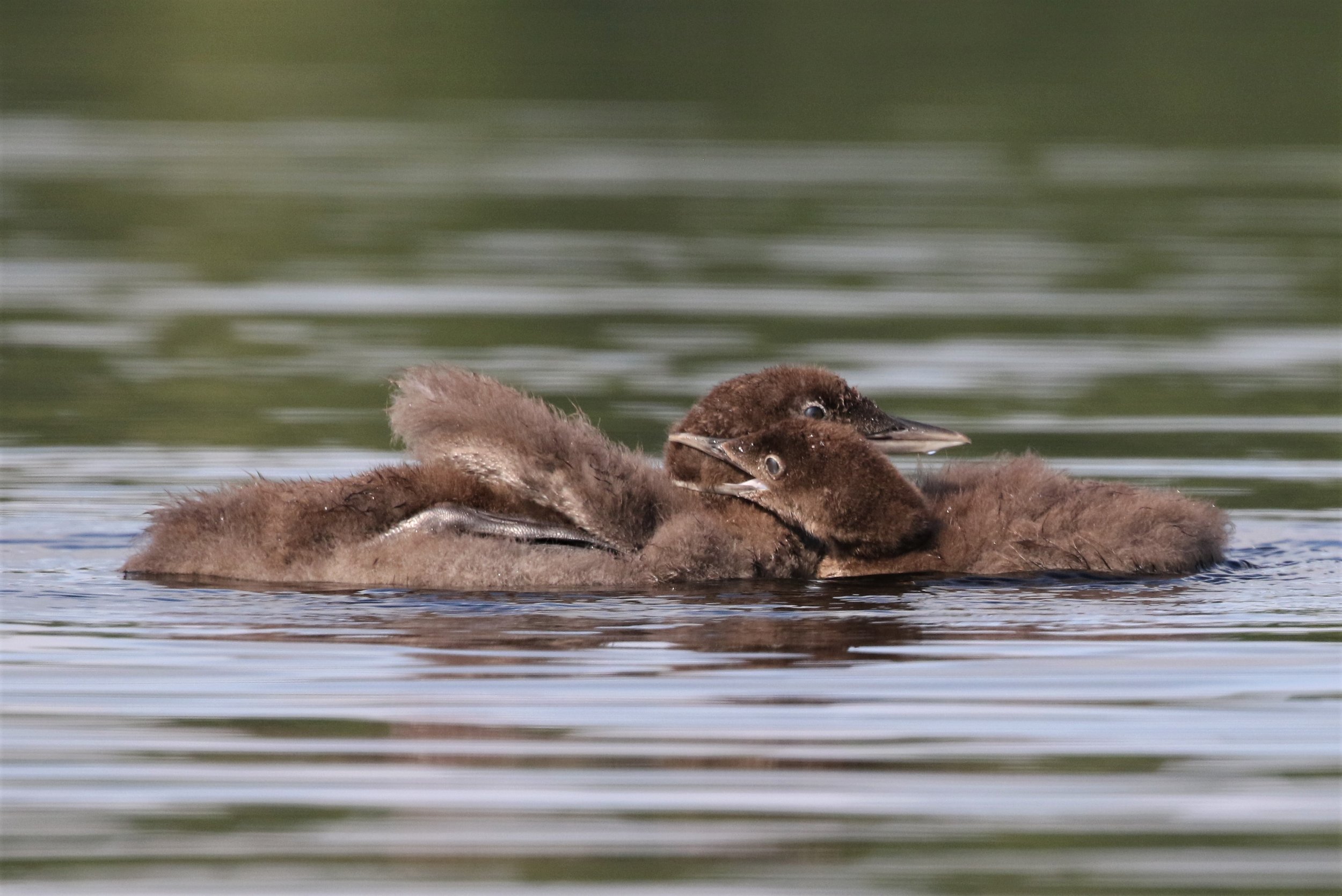Nesting & Reproduction
Loons are long-lived (20-30 years!) and territorial, commonly returning annually to the same lake to breed. They are usually six to seven years old before they establish a breeding territory with their first mate.
In the spring, males migrate back to their breeding lakes to establish a territory for nesting. The females follow days to weeks later, often rejoining the male from the previous year on the same territory. Courtship behavior is very subtle and quiet, including side-by-side swimming, bill dipping, circling, and soft hoots between the pair.
Do loons mate for life?
Banding studies have shown that loons do not mate for life and occasionally do switch mates or territories. Loons have been shown to be more loyal to their breeding territories than their partners. When one loon dies, the remaining member of the pair will find another mate. Additionally, another loon or pair may intrude on a territory, and one or both birds could be displaced.
Nesting
Nests are usually made in vegetation on the edge of an island, bog mat, log, or even on a large rock, adjacent to deep water. These locations enable a loon to slip into the water virtually unnoticed if danger threatens. Their nests vary from a shallow scrape to a large (~1-2 feet across) bulky bowl of vegetation.
Incubation usually begins in May or early June, although it can start later, particularly if the first nest fails and the birds renest. One or two large (~3-4 inches long) oval eggs are laid. The eggs are olive-green to brown in color and often have brown spots. They are well camouflaged in the nest if the parent goes off to eat or bathe.
This loon is carefully turning its eggs.
Incubation is shared by both parents for ~26-30 days until the chicks hatch. This is a vulnerable time for the loons and their nests, as they are at risk of disturbance by predators, humans, and water level fluctuations. If an incubating bird is disturbed, it may hurriedly scramble off the nest and wing-row across the water. In this panicked state, they may accidentally knocking an egg off the nest in their hurry to get away.
Alternatively, some birds will “stick” and remain on the nest until they absolutely have to move. They may freeze in a “hangover” position, which enables the bird to hide itself in the vegetation and minimize the chance that a predator would see it. Loons can also easily slip into the water from this position as a last resort, since their head is very close to the water.
If you observe a loon in a hangover, it is likely that you are too close to the nest for the bird’s comfort. Please move away and look through your binoculars. After a while, you should see the loon resume a normal incubating position with its head up in the air, calmly looking around.
Loonlet Development
Day 1-2
The chicks are little black, downy “puff-balls” when they first hatch. The first egg laid hatches first, and that chick is a little bigger than the other chick. The chicks establish a dominance hierarchy by fighting the first day or two of their lives. The larger chick has the advantage and becomes the dominant chick, getting fed first by the parents. Occasionally the younger chick dies because it is not getting enough food or care.
1 week
During this time period, chicks spend a lot of time back-riding on their parents. This protects them from underwater predators and keeps them warm when they snuggle into the soft down under their parents’ wings.
2 weeks
Chicks molt into a lighter brown downy plumage. They continue to grow and explore their nursery area as they gain confidence in swimming.
3-4 weeks
Their bodies begin to elongate, and as their physical attributes continue to develop, they lose the ability to walk on land. Chicks become too large to back-ride, although they may still attempt it!
5-6 weeks
The chicks are able to catch their own meals, although they still rely on their parents for supplemental feedings. Juvenile feathers begin to emerge.
6-7 weeks
Adults leave the chicks for longer periods of time to fish. They look pretty goofy at this stage as the down is sticking out and feathers are coming in, especially when they stretch and show how scrawny their wings are in relation to their bodies!
8-9 weeks
Growth begins to slow. Juvenile plumage becomes fully developed, and they begin exercising their wings in preparation for flight
10-11 weeks
Chicks begin to test their flight abilities as their primary flight feathers are finally developed. At this point, chicks can feed themselves, although they will still beg for food.
12 weeks
Loon chicks reach fledgling age. Their primary flight feathers are last to develop, and, although they are the size of adults, the chicks are not able to fly until they are 11 to 12 weeks of age. They usually leave their natal lake after their parents, migrating to the coast for the winter, where they will spend the next two to four years before returning to the breeding grounds.













